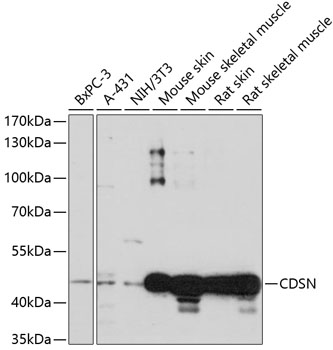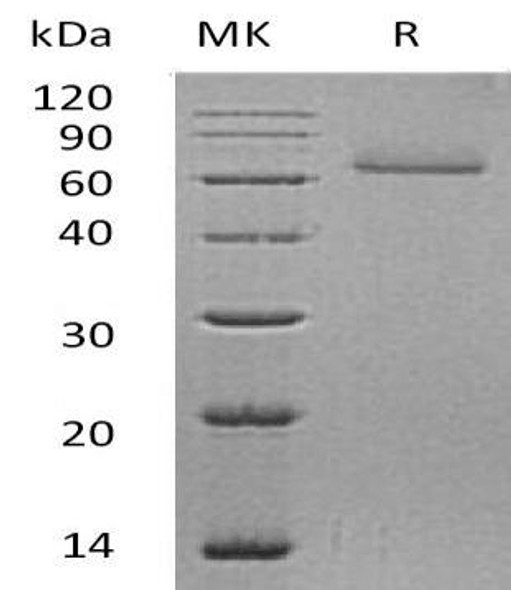Signal Transduction Antibodies 1
Anti-CDSN Antibody (CAB14602)
- SKU:
- CAB14602
- Product Type:
- Antibody
- Reactivity:
- Human
- Reactivity:
- Mouse
- Reactivity:
- Rat
- Host Species:
- Rabbit
- Isotype:
- IgG
- Antibody Type:
- Polyclonal Antibody
- Research Area:
- Signal Transduction
Description
| Antibody Name: | Anti-CDSN Antibody |
| Antibody SKU: | CAB14602 |
| Antibody Size: | 20uL, 50uL, 100uL |
| Application: | WB |
| Reactivity: | Human, Mouse, Rat |
| Host Species: | Rabbit |
| Immunogen: | A synthetic peptide corresponding to a sequence within amino acids 100-200 of human CDSN (NP_001255.3). |
| Application: | WB |
| Recommended Dilution: | WB 1:500 - 1:2000 |
| Reactivity: | Human, Mouse, Rat |
| Positive Samples: | BxPC-3, A-431, NIH/3T3, Mouse skin, Mouse skeletal muscle, Rat skin, Rat skeletal muscle |
| Immunogen: | A synthetic peptide corresponding to a sequence within amino acids 100-200 of human CDSN (NP_001255.3). |
| Purification Method: | Affinity purification |
| Storage Buffer: | Store at -20'C. Avoid freeze / thaw cycles. Buffer: PBS with 0.02% sodium azide, 50% glycerol, pH7.3. |
| Isotype: | IgG |
| Sequence: | GGSA GSFK PGTG YSQV SYSS GSGS SLQG ASGS SQLG SSSS HSGS SGSH SGSS SSHS SSSS SFQF SSSS FQVG NGSA LPTN DNSY RGIL NPSQ PGQS SSSS Q |
| Gene ID: | 1041 |
| Uniprot: | Q15517 |
| Cellular Location: | Secreted |
| Calculated MW: | 51kDa |
| Observed MW: | 52kDa |
| Synonyms: | CDSN, HTSS, HTSS1, HYPT2, PSS, PSS1, S |
| Background: | This gene encodes a protein found in corneodesmosomes, which localize to human epidermis and other cornified squamous epithelia. The encoded protein undergoes a series of cleavages during corneocyte maturation. This gene is highly polymorphic in human populations, and variation has been associated with skin diseases such as psoriasis, hypotrichosis and peeling skin syndrome. The gene is located in the major histocompatibility complex (MHC) class I region on chromosome 6. |
| UniProt Protein Function: | CDSN: Important for the epidermal barrier integrity. Defects in CDSN are the cause of hypotrichosis type 2 (HYPT2). A condition characterized by the presence of less than the normal amount of hair. Affected individuals have normal hair in early childhood but experience progressive hair loss limited to the scalp beginning in the middle of the first decade and almost complete baldness by the third decade. Body hair, beard, eyebrows, axillary hair, teeth, and nails develop normally. Defects in CDSN are a cause of peeling skin syndrome (PSS); also known as peeling skin syndrome or deciduous skin or keratolysis exfoliativa congenita. A genodermatosis characterized by generalized, continuous shedding of the outer layers of the epidermis. Two main PSS subtypes have been suggested. Patients with non-inflammatory PSS (type A) manifest white scaling, with painless and easy removal of the skin, irritation when in contact with water, dust and sand, and no history of erythema, pruritis or atopy. Inflammatory PSS (type B) is associated with generalized erythema, pruritus and atopy. It is an ichthyosiform erythroderma characterized by lifelong patchy peeling of the entire skin with onset at birth or shortly after. Several patients have been reported with high IgE levels. CDNS mutations are responsible for generalized, inflammatory peeling skin syndrome type B (PubMed:20691404). |
| UniProt Protein Details: | Protein type:Cell adhesion; Secreted, signal peptide; Secreted Chromosomal Location of Human Ortholog: 6p21.3 Cellular Component: desmosome; cornified envelope; intercellular junction Molecular Function:protein homodimerization activity Biological Process: keratinocyte differentiation; cell-cell adhesion; epidermis development; skin morphogenesis; cell adhesion Disease: Peeling Skin Syndrome 1; Hypotrichosis 2 |
| NCBI Summary: | This gene encodes a protein found in corneodesmosomes, which localize to human epidermis and other cornified squamous epithelia. During maturation of the cornified layers, the protein undergoes a series of cleavages, which are thought to be required for desquamation. The gene is located in the major histocompatibility complex (MHC) class I region on chromosome 6. [provided by RefSeq, Jul 2008] |
| UniProt Code: | Q15517 |
| NCBI GenInfo Identifier: | 67782356 |
| NCBI Gene ID: | 1041 |
| NCBI Accession: | NP_001255.3 |
| UniProt Secondary Accession: | Q15517,O43509, Q5SQ85, Q5STD2, Q7LA70, Q7LA71, Q86Z04 Q8IZU4, Q8IZU5, Q8IZU6, B0S7V2, B0UYZ7, |
| UniProt Related Accession: | Q15517 |
| Molecular Weight: | 51,522 Da |
| NCBI Full Name: | corneodesmosin |
| NCBI Synonym Full Names: | corneodesmosin |
| NCBI Official Symbol: | CDSN |
| NCBI Official Synonym Symbols: | S; PSS; HTSS; HTSS1; D6S586E |
| NCBI Protein Information: | corneodesmosin; differentiated keratinocyte S protein |
| UniProt Protein Name: | Corneodesmosin |
| UniProt Synonym Protein Names: | S protein |
| Protein Family: | Corneodesmosin |
| UniProt Gene Name: | CDSN |
| UniProt Entry Name: | CDSN_HUMAN |
View AllClose







